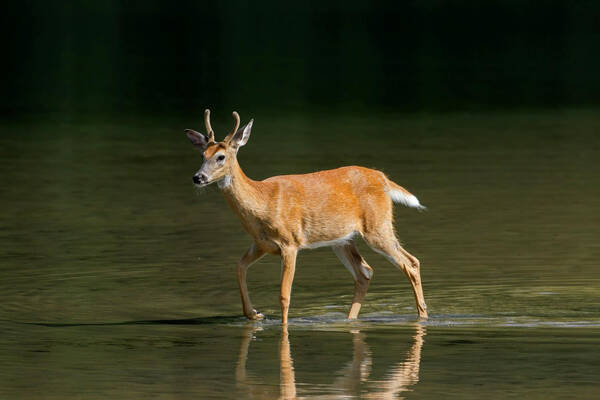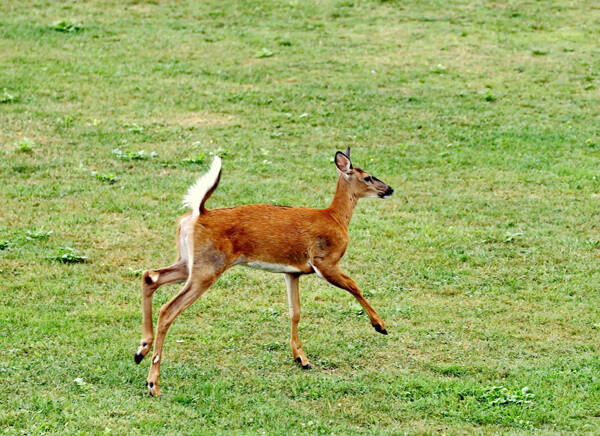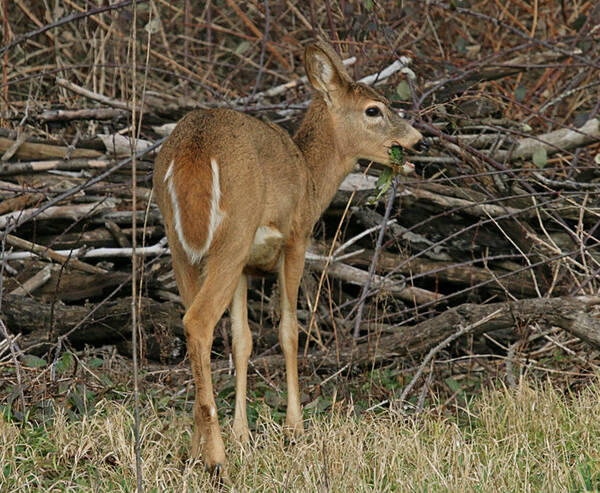Odocoileus virginianus
IUCN
LCBasic Information
Scientific classification
- name:Odocoileus virginianus
- Scientific Name:Odocoileus virginianus,White-tailed Deer,Key Deer,Key Deer Toy Deer, Cariacú, Venado Cola Blanca,Virginia Deer
- Outline:Ungulata
- Family:Artiodactyls Cervidae Odontocerus
Vital signs
- length:134-206cm
- Weight:40-137kg
- lifetime:About 15 years
Feature
The white-tailed deer gets its name because its tail is lifted up when it runs, and the white base of the tail is visible.
Distribution and Habitat
Origin: Belize, Brazil, Canada (Saskatchewan, Ontario, Nova Scotia, Newfoundland, Manitoba, Labrador, British Columbia, Alberta, Quebec, New Brunswick), Colombia, Costa Rica, Ecuador, El Salvador, French Guiana, Guatemala, Guyana, Honduras, Mexico, Nicaragua, Panama, Peru, Suriname, United States (Kansas, Delaware, New Jersey, Mississippi, Wyoming, Wisconsin, Texas, Massachusetts, Ohio, Kentucky, New Hampshire, Georgia, Rhode Island, Louisiana, New Mexico, Arizona, New York, West Virginia, Florida, Missouri, Alabama) , Connecticut, Oklahoma, North Carolina, North Dakota, Tennessee, Virginia, South Dakota, Minnesota, Washington, Illinois, Colorado, Arkansas, Idaho, Michigan, Nebraska, Iowa, Indiana, Pennsylvania, South Carolina, Oregon, Maine, Montana, District of Columbia, Vermont, Maryland) and Venezuela.
Introduced: Canada (Edward I Island), Czech Republic, Finland, New Zealand and Slovakia.
White-tailed deer have a wide range of habitats, from northern temperate to subtropical
Appearance
The white-tailed deer is 1.34-2.06 meters long, 0.92 meters high at the shoulder, and has a tail length of about 10-28 centimeters. The ears are small; the dorsal branches of the horns are simple; the glands are small, only about 3 centimeters long, and there are white hairs around the glands. The fur of the white-tailed deer is a little reddish in summer and turns gray in winter. The horns are hollow and actually weigh much less than they look. Deer antlers and horns look similar, but they are made of different tissues and grow in different ways. The surface is skin, which falls off every year and grows again. Deer antlers grow from two spherical protrusions on the frontal bone at the top of the deer's skull, just like plants sprouting from the ground. Deer antlers are usually divided into branches, and each new branch adds a branch. Just like claws, nails and hair. Horns grow from the bottom to the top and usually accompany the animal throughout its life. The horns are hollow an
Details
White-tailed Deer (scientific name: Odocoileus virginianus) English White-tailed Deer, Key Deer, Key Deer Toy Deer, Spanish Cariacú, Venado Cola Blanca, is a large herbivore of the Cervidae family and the genus Odocoileus.

White-tailed deer are the most vigilant and timid species among deer. They typically swing their tails from side to side when startled and flee. They are very agile and can move through the intricate terrain of the forest at speeds of 50 kilometers per hour. White-tailed deer are also good swimmers and often enter large streams and lakes to escape predators or insects or visit islands. Their territories are usually small, usually one square kilometer or less. White-tailed deer do not migrate in the winter, but forage within their own territories during heavy snowfalls. They are known for repeatedly using the same paths when foraging, but will not rest during the day in areas they have used before.
White-tailed deer are generally considered solitary, especially in the summer. The basic social unit is the female and her fawns. They also graze in groups, sometimes as many as hundreds. Females usually stay with their mothers for about two years, but males leave the group within the first year. Bucks may form temporary small groups of 2-4 during the summer, but these groups disband before the mating season. Males begin estrus in September, and are completely focused on gaining access to mating rights. They do not guard females (like elk do), but rather fight one another individually, using antler clashes to gain access to specific females.
White-tailed deer are very careful indeed to keep their offspring away from predators. While foraging, females leave their offspring in dense vegetation for about four hours at a time. While waiting for the female to return, the fawns lie flat on the ground with their necks stretched out, well camouflaged against the forest floor. Fawns retain their feces and urine until the mother arrives, at which point she swallows any excrement from the fawn to discourage predators from finding any sign of the fawn.

White-tailed deer make several types of vocalizations, such as grunts, wheezes, and bleats. These vocalizations, along with other sounds and gestures, are used to communicate. Injured deer will make startling "blatts" or loud roars. The whistles or snorts of disturbed white-tailed deer are the most commonly heard sounds. White-tailed deer are not particularly vocal, although fawns may occasionally bleat. White-tailed deer have scent glands on all four limbs, on the outside of each hind leg and between the two parts of the hoof on the inside of each hind leg. The scent from these glands is used to communicate with other deer, and the secretions become particularly strong during the mating season.
White-tailed deer are a crepuscular species, foraging primarily from before dawn to several hours later and again from dusk to dusk. White-tailed deer feed on a variety of vegetation, depending on the available plants in their habitat. In eastern forests, they feed on buds and branches of trees such as maple, sassafras, poplar, aspen and birch, as well as many shrubs. In desert areas, plants such as yucca, cactus and various tough shrubs are the main components of their diet. Conifer leaves are also used to fill the stomach, usually in the winter when other foods are scarce.
Most white-tailed deer (especially males) mate in their second year of life, although some females occasionally mate as early as seven months of age. The species is a polygynous mating system, although they may form an attachment and stay with a doe for days or even weeks until she comes into estrus. It is seasonally polygynous, usually beginning in November and lasting a short time, around 24 hours. If the doe has not mated, a second estrus will occur about 28 days later. Mating occurs from October to December, and the gestation period is about 6 and a half months. In the first year of reproduction, females usually give birth to one fawn, but in subsequent years two (occasionally three or four) fawns are born. Fawns are able to walk at birth and are able to nibble on vegetation after a few days.

White-tailed females are very protective of their young. While searching for food, females leave their offspring in a secluded spot for about 4 hours at a time. While waiting for their mother to return, the fawns lie flat on the ground with their necks stretched out, well camouflaged against the forest floor. Fawns begin to follow their mother on foraging trips when they are about 4 weeks old and fully regurgitate by two months old. White-tailed deer fawns are nursed for 8-10 weeks before weaning. Young males leave their mothers after one year, but young females usually stay with their mothers for two years.
The main problem of the species in the United States and Canada is overpopulation, which has the consequence of causing problems for humans because of pests, accidents, and the most serious one is the spread of epidemics like Lyme disease and other diseases. Therefore, policies are needed to reduce the number. At the same time, the southern population faces survival problems, some of which are threatened by different causes. Several protected areas have been established in the range of species survival. According to foreign media reports in 2014, the US National Park Service plans to allocate $1.8 million in funds to recruit snipers to carry out three white-tailed deer hunting operations in the next five years. It is understood that in recent years, the number of white-tailed deer in Antietam and Monocacy in Maryland and Manassa in Virginia has far exceeded expectations, so they have become the three major battlefields for hunting. Since ordinary people cannot hunt deer in the park, their numbers continue to increase, with Monocacy even having 230 deer per square mile. According to the Associated Press, the U.S. National Park Service hopes to reduce the number to 15-20/square mile. According to statistics, the hunting plan will kill up to 2,800 white-tailed deer in the next five years. After the plan is completed, the park service will use chemical contraceptive measures to continue to maintain their numbers. The U.S. National Park Service said that too many deer will destroy the local flora, so they proposed this plan to protect the environment. The public review of this plan will continue until the 3rd of next month, when a decision will be made whether to implement it.
On November 20, 2021, according to CCTV News, researchers at Pennsylvania State University in the United States said in a pre-published paper on October 31 that they found that the new coronavirus spread explosively in white-tailed deer in the United States. Research published by the U.S. Department of Agriculture previously also showed that white-tailed deer were infected with the new coronavirus in 2019. In December 2021, a study published in the British journal Nature found that scientists detected at least three new coronavirus variants in free-range white-tailed deer at several locations in northeastern Ohio, USA.
Listed in the IUCN Red List of Threatened Species in 2015 ver 3.1-Least Concern (LC).
Protect wildlife and eliminate game.
Maintaining ecological balance is everyone's responsibility!








